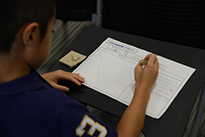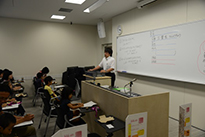- HOME >
- Oishi Fossils Gallery of Mizuta Memorial Museum >
- Summer Workshop of the Fossil Gallery

The Gallery offered two sessions of summer workshop for preschool to junior high school students in July and August this year. This Workshop was held with the backing of Chiyoda Board of Education. 185 children in 12 groups joined the workshop. The three hour long workshop consisted of four activities, which are described below:
In this activity, students observed the fossils on display in the gallery to determine such things as what sort of things the animal ate, how they obtained their food, and its level of intelligence. Students would then take a multiple-choice quiz. If they answered the questions correctly, they would receive an original stamp of an extinct animal from the fossil gallery. Children listened closely to the curator’s explanations, occasionally emitting sounds of surprise and wonder.
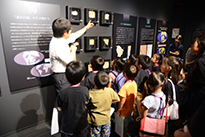
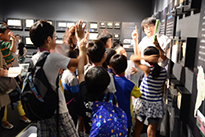
The vast majority of fossils on display in the gallery are approximately 100 million years old. To give children a sense of this length of time, they used a set of building blocks―with one block representing 2 million years―stacking 50 blocks, or 100 million years. The children stacked blocks—which were color coded by time period―in front of a time line that described the largest development during each age, until they added the final block representing the birth of mankind. The children occasionally had trouble stacking the blocks, some of which were small in size, but persevered through each mishap until the stack was complete.
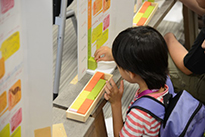
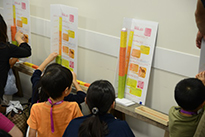
Fossils are often contained in a rock called “nodule.” Most of the fossils exhibited in the gallery were discovered in nodules. The fossils from these nodules have a depth of body and retain the shape of the original living thing from which it came. In this activity, participants challenged to break rocks with a hammer in order to find fossils. The breakability of each nodule varied from sample to sample, but under the curator’s direction, every child was able to extract the fossil in the end. Children attached a description label to the fossils with his/her name as a person who made the specimen. Participants took the specimen back to their homes.
*In this activity, which was also part of last year’s program, those participants who requested it were also able to excavate samples that contained crystals or minerals.
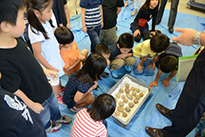
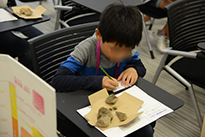
In this activity, students sketch 95 million year old fossils from Lebanon and, using the gallery’s mineral encyclopedia designed specially for this program, attempt to identify the animals from the fossils.
Taught by the curator to draw not just the image of the fossil, but to closely observe the shape of the creature for their sketch, the students worked on their sketches with great enthusiasm. After sufficiently observing the mineral sketches, students would then consult the encyclopedia to identify the fossils. Given the ancient status of the 95 million year old fossils, occasionally parts were missing, causing them to appear different from their images in the encyclopedia and, consequently, difficult to identify. At last the answers were given, and all of the children, correct or not, voiced their enjoyment of the activity.
